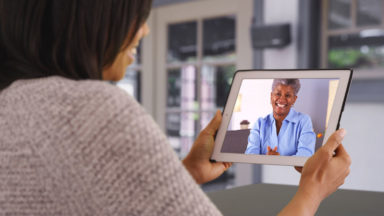
During this COVID-19 global pandemic the need for services to be rendered using technology has never been greater. Many of us may have already set up email accounts with our healthcare providers in order to occasionally contact our primary care physicians for advice or a prescription renewal. Now, this technology is as vital as ever since many of us are staying close to home or in many cases, we are sheltering in place until it is deemed safe to go about our regular activities.
Why use telehealth?
Telehealth is a great way to use technology – your phone, tablet, or computer – to access health care. For patients (especially seniors or older adults) who might have mobility or limited transportation options, telehealth is a viable and accessible option. It also makes health care accessible for those who might live in rural or isolated communities. Telehealth makes it possible to have access to medical specialists including your own personal physician and can often improve communication between the patient and the health care team. Telehealth Is also beneficial for one’s own health management.
If using telehealth, it is important to be prepared for your virtual “visit.” This way you can ensure all your questions answered and use your time, as well your doctor’s time, wisely and efficiently.
Be sure to prepare ahead of time by doing the following:
- Start by checking with your health care group to see if it has a telehealth portal. For example, Vanderbilt Medical Group has a portal called MyHealthAtVanderbilt.com. Call your health provider or search for it online. You can then set up a personal account using your email account.
- Decide how you want to consult with your doctor. For simple prescription refill permissions, an email through the portal will most likely suffice. Your doctor can contact the prescription provider and grant permission for refills. For a virtual visit, you will need to make an appointment for a visit as you normally do.
- Prepare your medical questions ahead of time and write them down, if necessary. Take notes as you consult with your physician. This ensures nothing is forgotten.
Healthcare Websites and Apps
Most major health insurance companies have their own website portals and apps in the Apple App Store and on Google Play where you can find coverage details and doctor recommendations. Most major health systems (such as Vanderbilt Health and TriStar Health) have their own website portals so you can access your own personal health information and schedule appointments online.
The following websites and apps may be helpful to use in place of or in conjunction with your current healthcare:
- Dr+ on Demand (offers urgent care, behavioral health, preventative health, and chronic care support): Available at doctorondemand.com.
- Teladoc (offers everyday care, children and family, mental health, medical experts, and wellness and prevention support): Available at www.teladoc.com.
- MDLive (offers urgent care, counseling, psychiatry, and dermatology support): Available at www.mdlive.com.
- LiveHealth Online (offers everyday care, psychology, psychiatry, and allergy support): Available at livehealthonline.com.
- Talkspace (offers therapy and psychiatry support): Available at www.talkspace.com.
- Better Help (Offers counseling support): Available at www.betterhelp.com.
- Amwell (offers urgent care, therapy, psychiatry, and specialty support): Available at amwell.com/cm/.
- K Health (offers the ability to text a doctor, find local labs, and refill your prescriptions): Available at www.khealth.ai.
Telehealth visits may seem nerve-wracking initially to set up but relax in knowing that as difficult and overwhelming as the telehealth visit may be for you, it is most likely a new experience for your doctor, too. Everyone is learning new technology and with the Safer at Home health order in place, everyone is finding new ways to be able to deliver good healthcare under new conditions and circumstances. It is likely that telemedicine will be a technology we will all learn to use more readily in the future.


